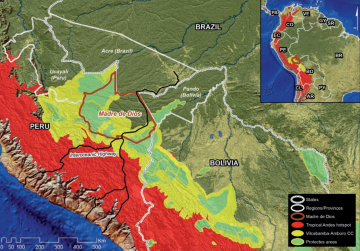
The Madre de Dios (MDD) region of Peru is a biologically and culturally diverse area that forms a key conservation corridor spanning 30 million hectares of protected areas in the Tropical Andes Biodiversity Hotspot, and connecting the Andean foothills with the Amazon. Prior to 2010, the construction of the interoceanic highway began. This road is an important economic corridor that crosses the Andes to connect ports on the Pacific coast with MDD as well as road networks beyond, all the way to São Paulo, Brazil.
In 2014, the Smithsonian’s National Zoo and Conservation Biology Institute’s Center for Conservation and Sustainability was approached by a hydrocarbon company to develop a biodiversity action plan for a natural gas infrastructure project in MDD. The company wanted to understand their proposed project in a broader regional context and to understand how to sustainably integrate gas infrastructure into the landscape in the context of landscape change driven by multiple sectors. Between 2015 and 2017, a participatory scenario planning process was developed and carried out to evaluate the outcomes of different development trajectories and to feed directly into governmental strategic planning for MDD. The process was designed to incorporate stakeholder priorities and visions of what the future landscape might look like. The stakeholder consultation implemented as part of this project went beyond conventional assessment of environmental and social impacts at a project level to consider synergies and cumulative impacts of infrastructure systems at a landscape level.
Guiding principle #9 Transparent, Inclusive, and Participatory Decision-Making, from the International Good Practice Principles for Sustainable Infrastructure.



